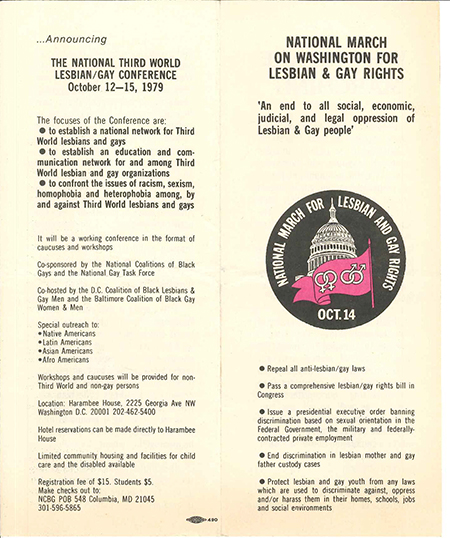Month: October 2017
Advocate.com publicizes our interactive map
20170504
By: Scott Ragan
We’re thrilled to see Advocate.com — the online presence for The Advocate magazine — share a video about the Project with its online community. Watch below (brief ad may play first).
Click here to view the video on Advocate.com.
Could Walt Whitman’s Brooklyn Home Become a Landmark?
20171025
By: Susan de Vries
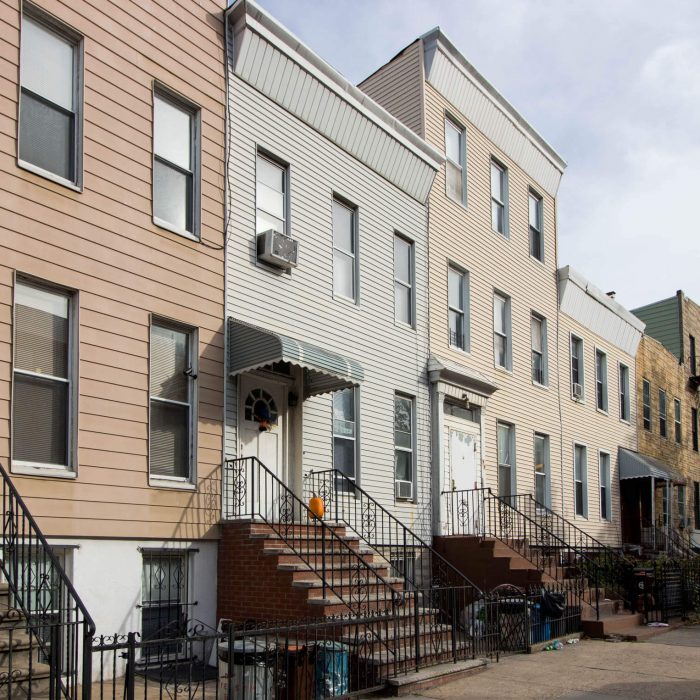
One of America’s most influential 19th century poets, Walt Whitman was a Brooklynite for 28 years and through many changes in career — printer, journalist, teacher. But few physical reminders of his time in the borough remain.
One home connected to Whitman, 99 Ryerson Street in Wallabout, is where he self-published Leaves of Grass, now considered a masterwork of American literature. The modest wood-frame house is not a New York City landmark nor within a local historic district, and one Brooklyn resident is hoping to change that.
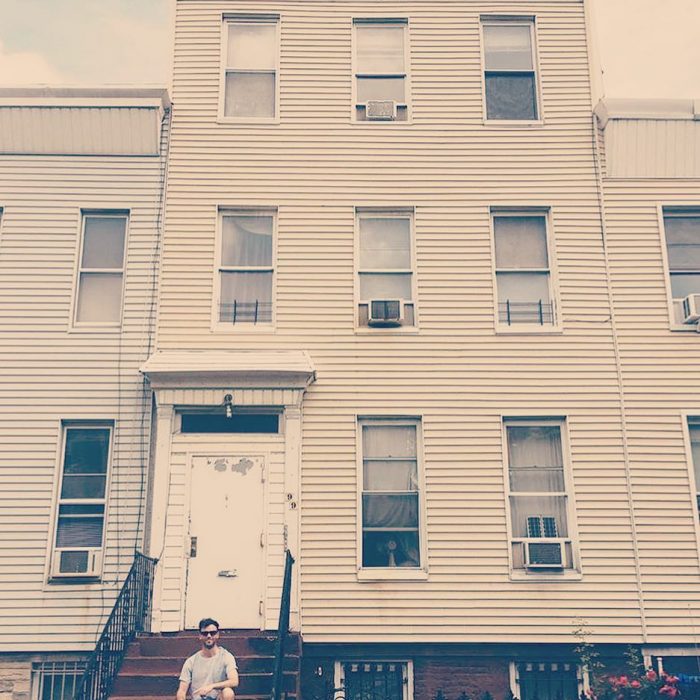
Brad Vogel, lawyer, poet and preservationist, was surprised to learn from the NYC LGBT Historic Sites Project that Whitman’s home was not already a local landmark. Vogel recently submitting a formal Request For Evaluation (RFE) to the Landmarks Commission to move forward a discussion about the cultural and historic significance of the house.
The simple RFE form offers the general public a way to submit an individual, interior or scenic landmark for consideration — all submissions must be 30 years or older and not already designated within a historic district.
In urging Landmarks to consider the property, Vogel asked that the building not be evaluated on architectural grounds alone or considered with a “rigid adherence to a pristine-architecure-only landmarking mindset.” Indeed, the house, like many pre-Civil War structures in Brooklyn, has been altered over time.
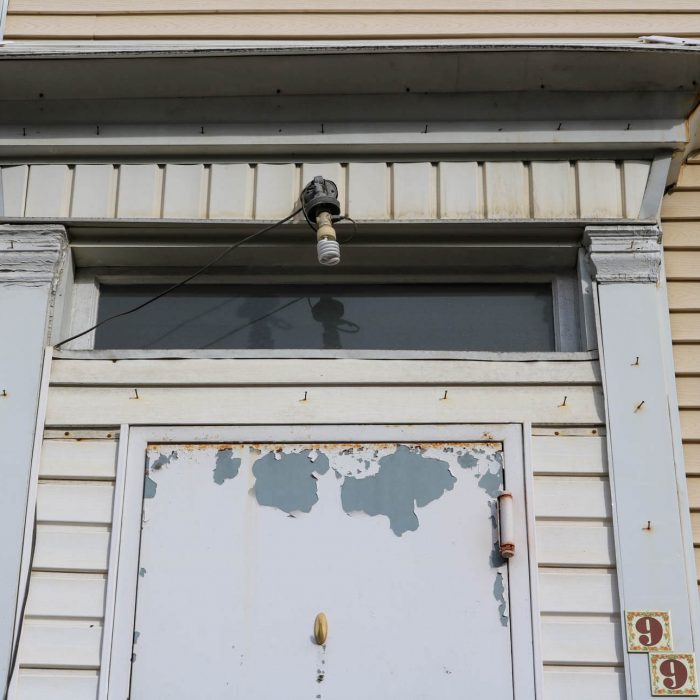
Now covered with vinyl siding, most of the — likely modest — architectural details the building once had are hidden from view. The exact date of construction is unknown, but it was Whitman’s home in 1855 when he published the first version of Leaves of Grass. Whitman continued to revise the work until his death in 1892.
As Brownstoner columnist and preservationist Suzanne Spellen argued in writing about the house, “what makes it special among all the other covered-up, remuddled pre-Civil War houses houses on this block is that it is the last remaining home of the great Brooklyn (and American) poet.” Whitman moved from the home in 1862 and left Brooklyn altogether in the 1870s.
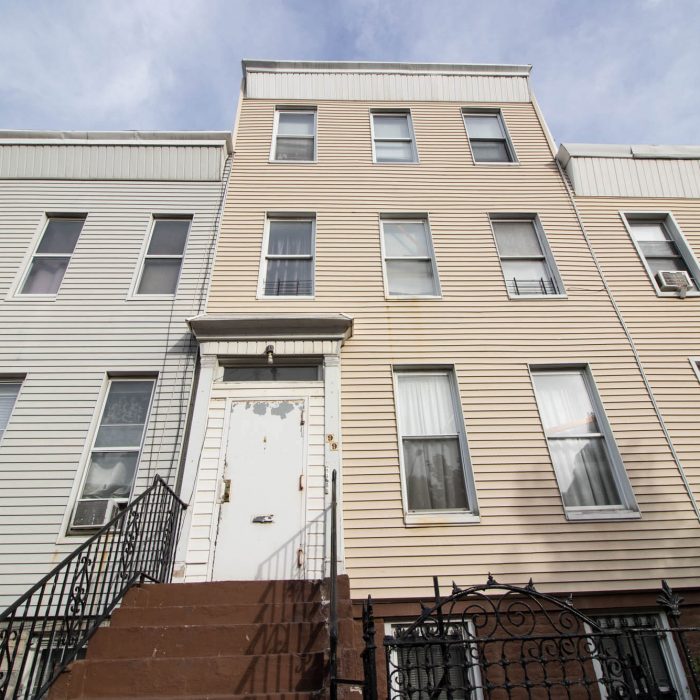
Vogel has reached out to other preservationists to weigh in on the matter. In a letter of support for Vogel’s RFE submission, the Historic Districts Council asked for serious consideration of the house for its “great cultural significance,” noting that while the house has been altered, “one cannot restore what is not there, and that is why it is imperative that this building remain standing.”
A few other memorials here honor Brooklyn’s poet. There is a plaque on the exterior of the Eagle Warehouse which was constructed on the original location of the Brooklyn Daily Eagle, where Whitman once worked.
His poem “Crossing Brooklyn Ferry” is inscribed along the railings of Fulton Ferry Landing and Walt Whitman Park is located off Cadman Plaza East in Downtown Brooklyn. Not far from Whitman’s house, the Walt Whitman Houses, a NYCHA development, bear the acclaimed author’s name.
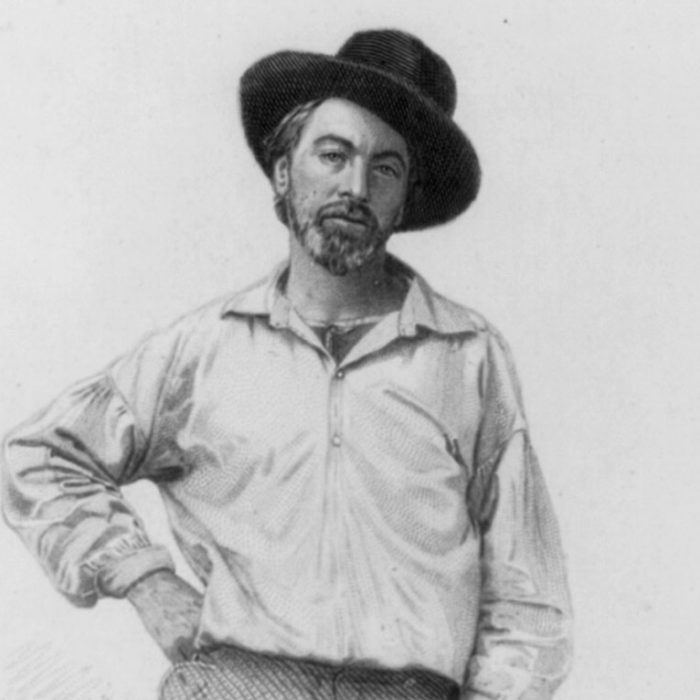
There is a historic sited dedicated to Whitman on Long Island. The small Huntington Station farmhouse where Whitman was born, in 1819, and where he lived until moving to Brooklyn at the age of four was saved in the 1950s and is now a state historic site.
While Landmarks considers the RFE, Vogel hopes the idea of preserving Whitman’s home will stir the imagination of New Yorkers and lead to more thorough scholarship about the house.
“We’re going to need to rely in large part on a groundswell of public outcry,” Vogel told Brownstoner. “Imagine if this building were demolished five years from now because we did not act: We would lose one of the city’s only remaining tangible links to Walt Whitman and one of America’s most celebrated literary works.”
All photos by Susan de Vries for Brownstoner, with exception of Instagram post by Brad Vogel (@bowerybird) and image of Walt Whitman circa 1854 (via Library of Congress).
Click here to read the article on Brownstoner.com.
Call for Papers: Co-director to guest edit scholarly journal’s LGBTQ heritage edition
20171019
Change Over Time, a semiannual journal from the University of Pennsylvanis focusing on history, theory, and praxis of conservation, has invited Project co-director Ken Lustbader to serve as guest editor for their Spring 2019 issue, focused on LGBTQ heritage.
Description below, or click here for the call as PDF.
CALL FOR PAPERS
The journal Change Over Time: An International Journal of Conservation and the Built Environment, published by the University of Pennsylvania Press, invites submissions for the Spring 2019 issue.
LGBTQ Heritage | Guest Editor: Ken Lustbader
In spite of the immense historic and cultural contributions of LGBTQ Americans, the LGBTQ community at large is among the least represented in our national, state, and local designation programs. To date, only eleven of the more than 92,000 sites on the National Register of Historic Places have been listed for their primary association with LGBTQ history. This underrepresentation has prevented effective advocacy and educational opportunities, leaving potentially significant sites and histories unappreciated, uncelebrated, and potentially endangered.
Over the past five years there has been growing recognition of the importance of LGBTQ place-based history by cultural heritage professionals, historians, and advocates. Place-based heritage provides a unique opportunity to illustrate the richness of LGBTQ history and the community’s contributions to American culture. Examples include historic sites associated with arts and architecture, important social centers such as bars and LGBTQ organization locations, places related to oppression and protest, and residences of notable figures.
This issue, published in commemoration of the 50th anniversary of the Stonewall Uprising, will explore questions related to LGBTQ cultural heritage: What are the challenges in identifying an often invisible and, at times, transient and denied history? How can historians and preservationists ensure for diverse representation of LGBTQ communities? How does one address significance and architectural integrity when recognizing LGBTQ sites that are often architecturally undistinguished and frequently altered?
We welcome contributions from US and international contexts on a range of topics: researching and documenting LGBTQ place-based sites; exploring rural, urban, and suburban LGBTQ narratives; approaches for categorization of resource types and cultural significance; challenges related to official recognition of LGBTQ-related sites; and solutions for interpretation and educational opportunities.
Submissions may include case studies, theoretical explorations, evaluations of current practices, or presentations of arts- or web-based projects related to LGBTQ cultural heritage.
Abstracts of 200-300 words are due 5 January 2018. Authors will be notified of provisional paper acceptance by 19 January 2018. Final manuscript submissions will be due mid May 2018.
Submission
Articles are generally restricted to 7,500 or fewer words (the approximate equivalent to thirty pages of double-spaced, twelve-point type) and may include up to ten images. See Author Guidelines for full details at cotjournal.com, or email Senior Associate Editor, Kecia Fong at [email protected] for further information.
“Why We Are Marching:” Remembering the October 1979 March on Washington
October 14, 2017
This past weekend marked the anniversary of the 1979 National March on Washington for Lesbian and Gay Rights. Revisiting and rereading the information circulated to inform the LGBT community — and the public at large — of the need for this organizing is especially pertinent in our current political climate.
From “Why We Are Marching” flier, circulated in advance of the 1979 March on Washington:
“People throughout the nation are joining together to make the March on Washington for Lesbian and Gay Rights an inspiring and successful event, an event so important that it will propel lesbian and gay liberation forward in a way that hasn’t been done since the Stonewall Riot. The March on Washington will mark an important point in the evolution of lesbian and gay strength: the coming together of people and organizations from all over the country to work for the first national action planned by the lesbian and gay community.
“1979 is the tenth anniversary of the Stonewall Riots, the historic rebellion that helped to launch the current wave of lesbian and gay liberation. What better way for us to commemorate this anniversary than by mobilizing our sisters and brothers, as well as all our supporters, in the first national march for lesbian and gay rights. The march will be a celebration of our community solidarity and a sign of our political strength …
“… We will be in Washginton, building a broad, mass movement to fight for our freedom. Our demonstration will insist on freedom for all gay people and must reflect the anger and pride of our community in the face of government callousness, double-talk, and inaction. We should march on Washington, not plead with the government for token concessions, but to demand and struggle for liberation and an end to persecution.”
Click the flier below to enlarge and read.
VIDEO: “See the places where LGBT history took place”
October 11, 2017
For #LGBTHistoryMonth, an incredible video from EdLab at Teachers College at Columbia University. Featuring LGBT civil rights activist Dick Leitsch at Julius’ bar; Magie Dominic, actress and now archivist for the Caffe Cino, considered the birthplace of Off-Off-Broadway theater (recently listed to the NY State Register of Historic Places); and our incredible co-directors and project manager.
#LGBTHistoryMonth with Teachers College at Columbia University
20171010
By: Jackie Heltz
From EdLab at Teachers College at Columbia University.
Beginning in 1994, the month of October (February in the UK) was declared LGBT History month; a 31-day observance of lesbian, gay, bisexual, and transgender history and the history of the gay rights and civil rights movements.
As luck would have it, NLT is right on trend with the publication of this week’s Seen in NY episode: NYC LGBT Historic Sites Project. Founded by three graduates of the Columbia University Historic Preservation Program, the initiative is the first to “document historic and cultural sites associated with the lesbian, gay, bisexual, and transgender community in the five boroughs. ” Sites shed light on an otherwise invisible history and explore everything from theatres to bars, museums, residences, monuments, and even education institutions including Columbia University which was home to the first gay student organization in the nation back in 1967.
As an added bonus, I was invited to join a private NYC LGBT Historic Sites walking tour of the Greenwich Village. Over the course of about 90 minutes we covered nearly 50 sites including Eleanor Roosevelt’s apartment, Judson Memorial Church, the Little Red Schoolhouse, and Julius’– a bar brought into the public eye as the site of the 1966 Sip-In which was responsible for the state liquor authority’s reversal of its discriminatory policies against serving openly gay patrons.
We hope you’ll check out and share tomorrow’s SiNY!
Documenting and celebrating lesbian nightlife in NYC
20171011
By: Karen Loew
In all of New York City, four lesbian bars: Henrietta Hudson’s and the Cubby Hole, both in the West Village; Ginger’s in Park Slope, Brooklyn; and the Bum Bum Bar (pronounced boom-boom), in Woodside, Queens.
Artist Gwen Shockey is documenting the dwindling number of spaces in New York City dedicated to lesbian nightlife. CityLab spoke with Shockey, on the occasion of her recent exhibition “No Man’s Land” at the Leslie-Lohman Museum of Gay and Lesbian Art, and with our own Ken Lustbader about the “grassroots” research Shockey employs, through archival research, oral histories and photography.
Preserving the Meaning of Lesbian Bars
As gay people and places are more accepted than ever, their bars are dwindling in number—especially for women. Now artists are documenting what these spaces mean to the community.

Photo: The bar at Henrietta Hudson’s in New York, photo by Karen Loew.
We rolled through the doors of Henrietta Hudson’s early on a weekend night. It was well before the club became electric, but my new pal Angola was already excited. “I gotta look around,” she said as we entered the first of three rooms, complete with dance floor, pool table, two bars, and seating nooks. “This is like the Vatican.”
Somehow, neither Angola nor I had visited Henrietta’s before. This venerable “bar and girl” in Manhattan’s West Village is one of only four lesbian bars still open for business in all of New York City. That sounds shocking until you learn that San Francisco has none at all. This fact is part of the reason we finally stopped by: It was a celebration following the opening of “No Man’s Land,” an artwork exhibition by Gwen Shockey on display at New York’s Leslie-Lohman Museum of Gay and Lesbian Art. Her multimedia piece, installed for just one weekend in late September, responds to the reality of the dwindling number of spaces dedicated to lesbian nightlife.
At a time when gay people and places are more accepted than ever, the number of gay bars is declining. The decrease is far starker for women’s bars, because there were never as many of those in the first place. The causes include the “mainstreaming” that allows LGBTQ people to mingle elsewhere, the prevalence of hook-up apps, and the high cost of urban real estate. The circumstances vary in each place; some surmise, for example, that San Diego still sustains two lesbian bars because it’s a military town and a port town.
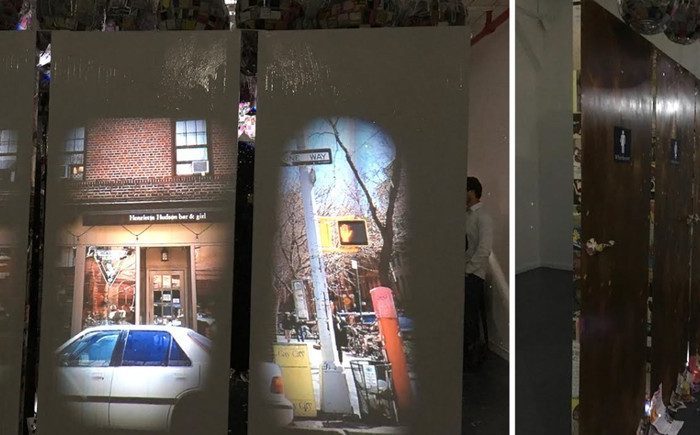
Scenes from the ‘No Man’s Land’ installation. Left: A video of Henrietta Hudson’s exterior. Right: A recreation of Henrietta Hudson’s restroom doors, with signs labeled “Whichever.” (Karen Loew)
Shockey’s exhibit echoes the scenes of New York’s four remaining lesbian bars. It feels like a bar in its own right: Lights are low, disco balls glint, drinks are poured, music plays, and visitors mingle. In the room with them are four unattached walls that represent the bars. On one side of each wall, a video shows a bar’s exterior; on the other side is a recreation of that bar’s bathroom doors. These four bars are Henrietta’s; the Cubby Hole, also in the West Village; Ginger’s in Park Slope, Brooklyn; and the Bum Bum Bar (pronounced boom-boom), in Woodside, Queens.
Shockey’s work laps into the realms of history, sociology, and preservation. Through recorded interviews with lesbians of every age and station, she’s learned about some 90 past bars and parties in New York, and photographed many of the addresses. Some of these interviews and prints will be included in her upcoming show in Brooklyn. Next, she’d like to make a book out of her photos and interviews, along with the histories she’s uncovered.
With this project, Shockey joins other gay artists whose work includes documenting the gay physical world, past and present—artists as concerned with spaces as with the body. Edie Fake makes intricate architectural drawings of real and imagined queer spaces from his native Chicago. Kaucyila Brooke has recorded and mapped past and present lesbian bars in three California cities, as well as Cologne, Germany. A faculty member at the California Institute of the Arts, Brooke says she began her ongoing project, “The Boy Mechanic,” in 1996 because, “It just felt pressing.” She wanted to capture the memories of places before they were lost—even though many of the places themselves weren’t much to look at.
Still, they must be seen, so Brooke took up documenting vernacular architecture: the everyday, often undistinguished structures that fill so much of the built environment.
“You have buildings that are designed to be something, by an architect,” she says. “But lesbian bars were usually something else before. And the bar owner tries to change the interior. This architecture that gets adapted and turned into something… is just interesting to me in terms of reusing things.”
It’s part of the “thrift economy” that expresses the “fugitive” nature of space for women and lesbians. Lesbian bars generally have understated facades, for example, in order to draw less attention from hostile men or police authorities.
Her photographs, videos, and other media have “to do with space, instead of looking at the body. Can you recognize anything by looking at a space? [Like] the difference between the surface and what’s underneath it, or inside of it?”
People who are trained in just that kind of detective work launched another effort—with more history, less art—two years ago. A team of historic preservation professionals is behind the NYC LGBT Sites Project, which aims to become an all-encompassing documentation of places where LGBT people have gathered—particularly when they illuminate the community’s impact on American culture. The project’s goal of “making an invisible history visible” is enriched by all kinds of participation, says Co-Director Ken Lustbader.
“We are really interested in having people understand the visceral connection to a location,” Lustbader said. “One of the most interesting ways that this [documentation] is being done is by the enthusiasts, and the more grassroots historians.”
That includes Shockey’s trove of interviews, Hugh Ryan’s research on the queer Brooklyn waterfront, or any number of entertaining Instagram accounts. In fact, it seems possible that whether rooted in New Orleans or floating on the internet, the diverse collectors of this invisible history are just getting started.
Because one thing’s for sure, lesbian bars are still essential. The heartbreaking words of interviewees in Brooke’s San Diego video still ring true. “Everybody out there was against us. And we would go into this little dark place, it was a bar, and find each other. And become friends. And care about each other,” one woman says.
“It was just nice to be in an environment where you could just be free. And just relax,” says another.
Ask the tall, skinny dyke from New Zealand who was having a high time at Henrietta Hudson’s on her very first night in New York City, already kissing a pretty girl and taking recommendations on where to find the best fried chicken. Or the handsome trans woman, recently moved to NYC from North Carolina, who happily accepted Angola’s offer to “be her gay mom” (and, impressively, set off to visit the three other lesbian bars in a single night). Or the bar patron who received advice from E., the mellow-fabulous bartender, on how to get a traditional male barber to cut a woman’s hair. Or anyone on the soon-crowded dance floor, if you could peel them away.
Lesbian and bisexual women of every description were free, and relaxed, and finding each other. It’s a thing of the present, not just the past.
Click to read the article on CityLab.
Marsha P. Johnson’s Place(s) in NYC’s LGBT History
October 6, 2017
The Death and Life of Marsha P. Johnson, a new documentary by David France, had its global premiere on Netflix today (tip to NYC locals: the film is also showing at the IFC Center).
We were fortunate to attend an advance screening of this moving film, which enforces the importance of Marsha P. Johnson and fellow activist, Sylvia Rivera, as early and critical advocates for trans rights (thanks to the LGBT Community Center for hosting this special event). A number of New York City locations and historic sites included in the film (rounded up below) stood out to us.
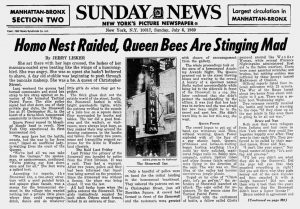
Article about the Stonewall uprising in the Sunday News, July 6, 1969.
The Stonewall Inn & Christopher Park
Marsha P. Johnson, and her involvement during and after the 1969 uprising, has received more and more (much deserved) attention in recent years. While Marsha herself admits that she did not show up at Stonewall until 2 am the first night, and therefore a few hours after the uprising began, she and other trans women of color, including Sylvia Rivera, were key participants who continued to play a crucial role in the fight for LGBT equality and transgender rights in the years to follow.
Visit our Stonewall Inn website entry (scroll down to “Related Media”) and listen as Marsha and Sylvia share their stories. Special thanks to project advisor Eric Marcus and his team at Making Gay History for providing us with these invaluable oral history interviews.
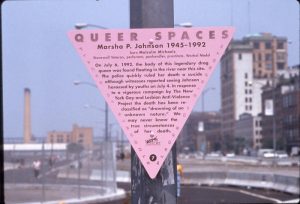
Pink triangle “Queer Spaces” signs were placed by RepoHistory at several NYC locations in the early 1990s to highlight sites of LGBT significance.
Christopher Street Pier
The pier and the Greenwich Village waterfront are shown throughout the Marsha P. Johnson documentary, illustrating their importance to her legacy. While already well-established as a gay cruising area from at least World War I, the pier also became closely associated with Johnson and Sylvia Rivera — both provided much-needed shelter, clothing, and support for homeless queer youth who lived and congregated on the piers.
On July 6, 1992, Johnson’s body was tragically (and mysteriously) found floating in the Hudson River near the piers. Her body was recovered and temporarily placed a half-block south of the Christopher Street Pier until transported to the morgue. The documentary follows Victoria Cruz, a friend of Johnson’s, as she tries to uncover the mystery behind Johnson’s death, which had been labeled a suicide (something those close to her never believed). A pink triangle was installed near the site of where her body was found in the early 1990s, as part of an initiative by RepoHistory to document important queer spaces in NYC. Read more about the waterfront’s LGBT history.
STAR House
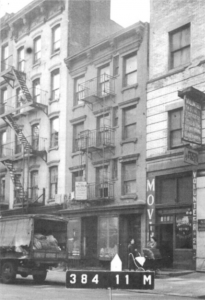 A number of LGBT rights organizations formed in the wake of Stonewall, including the Street Transvestite Action Revolutionaries (STAR), founded by Johnson and Rivera in 1970. Together, they established STAR House in a tenement at 213 East 2nd Street, in the East Village. This was STAR’s first (and it appears only) permanent home, providing refuge for homeless transgender youth from about November 1970 to July 1971. Rivera reflected on the space in a 1979 interview, “We had a STAR House–a place for all of us to sleep. It was only four rooms, and the landlord had turned the electricity off. So we lived there by candlelight, a floating bunch of 15 to 25 queens, cramped in those rooms with all our wardrobe. But it worked.”
A number of LGBT rights organizations formed in the wake of Stonewall, including the Street Transvestite Action Revolutionaries (STAR), founded by Johnson and Rivera in 1970. Together, they established STAR House in a tenement at 213 East 2nd Street, in the East Village. This was STAR’s first (and it appears only) permanent home, providing refuge for homeless transgender youth from about November 1970 to July 1971. Rivera reflected on the space in a 1979 interview, “We had a STAR House–a place for all of us to sleep. It was only four rooms, and the landlord had turned the electricity off. So we lived there by candlelight, a floating bunch of 15 to 25 queens, cramped in those rooms with all our wardrobe. But it worked.”
The building itself was unfortunately demolished by the 1980s and the lot remained vacant until a new residential building was constructed, but we were able to track down the above c. 1939 tax photo from the Municipal Archives.
Photo: The building that would become STAR House, in a c. 1939 tax photo. Courtesy of the Municipal Archives.
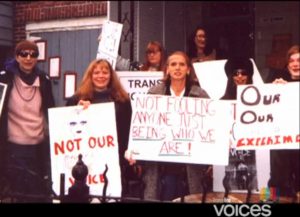
Chelsea Goodwin (left) and Rusty Mae Moore (center, with “Not Fooling Anyone…” sign), along with trans activists in front of Transy House. Source: “Changing House” documentary by Frameline Voices.
Transy House
While the documentary focuses on Marsha P. Johnson, it also highlights the work and influence of other notable transgender activists. Rusty Mae Moore and Chelsea Goodwin, who are interviewed in the film, founded Transy House in Park Slope, Brooklyn, in 1995. A transgender collective that operated until 2008, Transy House provided shelter for up to thirteen people at a time. As with STAR House, after which it was modeled, Transy House was a significant safe haven for trans and gender non-conforming people who had been kicked out of their homes, dropped out of school, or were refused housing at men’s and women’s shelters. It was also the last home of Sylvia Rivera.
Read more about the impact of Transy House and its influence on transgender inclusion in gay and lesbian rights legislation at the city and state levels in the late 1990s.
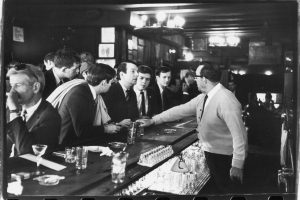
John Timmons, Dick Leitsch, Craig Rodwell, and Randy Wicker of the Mattachine Society during the 1966 “Sip-In” at Julius’ bar. Gift of the Estate of Fred W. McDarrah.
Julius’
While not directly associated with Marsha P. Johnson, the iconic Julius’ bar makes an appearance in the film. The Greenwich Village bar was the site of the 1966 “Sip-In,” at which members of the Mattachine Society, a gay rights organization formed in the 1950s, brought attention to the State Liquor Authority’s discriminatory policy of revoking the licenses of bars that served gay men and lesbians (one of several sites we’ve successfully nominated to the National Register of Historic Places for its significance to LGBT history).
In the documentary, we see Marsha’s friend and roommate Randy Wicker being interviewed at Julius’. Randy was actually one of the four participants of the “Sip-In.” In the famous photo taken by Fred W. McDarrah for the Village Voice (pictured here), you can see Randy in the back looking on as the bartender puts his hand on the glass. Learn more about this important pre-Stonewall event.
Discover more historic sites and learn more about transgender history in NYC with our curated theme.
Have recommendations for other sites significant to the transgender community in NYC? Share your suggestions and help us make trans history visible.
Featured in new LGBTQ design and lifestyle magazine
20170924
By: Deborah L. Martin
Exuberance, New York’s first LGBTQ luxury design and lifestyle magazine, has just premiered its first issue … and there we are, on page 40! Our sincere thanks to the editorial team at Exuberance for introducing your readership to the NYC LGBT Historic Sites Project.
And be sure to flip to the end for a special tribute to the Stonewall National Monument (page 98).
Click here to read Exuberance online.
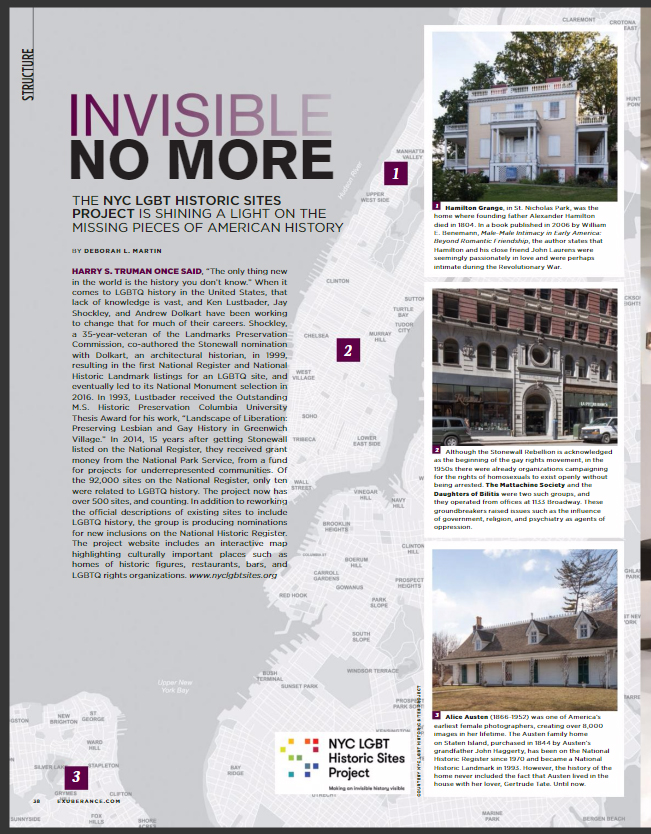
Featured imaged: “Gay Liberation,” sculpted by George Segal and unveiled in Christopher Park in 1992. Featured on page 98 of Exuberance magazine.
Celebrating LGBT History Month, all October long
20171002
FOR IMMEDIATE RELEASE
PRESS CONTACT
Ken Lustbader, NYC LGBT Historic Sites Project
p: (917) 848-1776 / e: [email protected]
NYC LGBT Historic Sites Project Celebrates
“LGBT History Month”
Throughout October, the Project will highlight important LGBT figures and events with new site listings, a curated tour, social media takeovers, Project launch event, and more
New York, NY – The NYC LGBT Historic Sites Project, a cultural heritage initiative working to document important LGBT sites throughout New York City, has announced its preliminary schedule of programming and events in celebration of October’s LGBT History Month.
LGBT History Month was established in 1994 by educators who recognized a void in the American historical narrative in which LGBT history was neither taught nor celebrated within the traditional educational system — public, parochial or private. Now, each year, shortly after schools return to session, historians, teachers, community groups, activists and the public at-large come together throughout the month to extol the achievements of LGBT individuals no longer with us, as well as those currently fighting and advocating for equal rights and visibility and working to further the movement into the 21st century.
“Our mission is to make the too-often unseen history of NYC’s LGBT community a visible and better-understood thread in our city’s historical fabric,” said Jay Shockley, co-director of the NYC LGBT Historic Sites Project.
Project activities and events during LGBT History Month will include:
- Saturday, October 7th: “Gay Green-Wood” trolley tour at historic Green-Wood Cemetery in Brooklyn. The tour will highlight Green-Wood Cemetery’s connection to LGBT history by showing tour goers the final resting places of important LGBT figures who made a lasting impact on American culture in the 19th and 20th centuries. Some notable “permanent residents” include conductor and composer Leonard Bernstein; “It’s Raining Men” co-author Paul Jabara; Emma Stebbins, sculptor of Central Park’s Bethesda Fountain (already featured on the Project website); activists Drs. Emery Hetrick and Damien Martin; Broadway lyricist Fred Ebb, and more. Green-Wood’s Manager of Preservation and Restoration, Neela Wickremesinghe, will share how these sites are preserved, and tour goers will have the opportunity to mark each grave with a rainbow flag. (more)
- Wednesday, October 11th: National Trust for Historic Preservation and the Project collaborate on a social media “takeover” of the Trust’s Instagram channel (@savingplaces). October 11th is significant both for National Coming Out Day and as the anniversary of the death of American gay rights activist Franklin “Frank” Kameny, whose childhood residence in Queens was among the first sites researched. Throughout the day, the Project will take to the Trust’s Instagram page to share sites and historic photos that speak to the importance of these and LGBT history more broadly.
- Thursday, October 19th to Tuesday, October 24th: The Project will celebrate the 29th annual NewFest (beginning October 19th) and LGBT cinema in general with a series of high-impact image mosaics. Follow on Instagram (@nyclgbtsites) as mosaics highlight films that feature storylines and characters important to LGBT cinema history, or that capture — whether as main set locations or as part of the backdrop of New York City — places with history that looms large in the LGBT community.
- Monday, October 30th: Project launch event at the Church of the Holy Apostles in Chelsea. The Project will celebrate its progress documenting LGBT history and geography in NYC, as well as look forward to what’s in store for the immediate future. The invitation-only event will feature remarks by George Chauncey, historian and author of Gay New York; Matthew Riemer, co-creator of the influential @lgbt_history Instagram account; and other special guests. The Church of the Holy Apostles is a venue of particular significance as it is one of the most important meeting places in New York City for LGBT organizations, dating back to the early post-Stonewall gay rights movement in the early 1970s. Members of the press may contact staff to request media pass.
- New historic sites published to the Project website. Stay tuned for the final week of October when the Project will be debuting newly-researched historically significant locations on its website, www.nyclgbtsites.org. Residences, gathering spaces and institutions coming to the Project’s interactive map include: the Kitty Genovese Residence in Kew Gardens, Queens; the Empire State Building, highlighting the years-long activism of GLAAD to light the famed skyscraper for NYC Pride in 1990; the Jimmy Zappalorti Memorial Tree on Staten Island; Escuelita, a former transgender Latina bar in Midtown Manhattan; the Bayard-Condict Building in NoHo, designed by master architect Louis Sullivan; and the 1990s Desi Dhamaka protests in Madison Square Park.
“We hope that our website inspires the LGBT community and youth, as well as the population more generally, who are too often not taught this particular history,” said Ken Lustbader, Project co-director. “Now more than ever it is imperative to raise public awareness about the community’s contributions to American history as well as the struggles it has faced in achieving acceptance and equality under the law. Our project encourages everyone to take a second look at the physical places we pass every day and to appreciate a history that, until our initiative, has remained largely invisible.”
LGBT History Month activities come on the heels of two recent NYC LGBT Historic Sites Project announcements and successes:
- Caffe Cino listed on the New York State Register of Historic Places: Nearly 60 years after the Caffe Cino opened at 31 Cornelia Street in Greenwich Village, we’re thrilled that our nomination of the famed Off-Off-Broadway cafe theater was listed on the New York State Register of Historic Places on September 14, 2017. The NYC LGBT Historic Sites Project’s nomination now goes to Washington, D.C. where it will be considered for listing on the National Register of Historic Places. (more)
- Debut of the Stonewall National Monument historical walking tour map: Stonewall National Monument — recognized as a national heritage site in 2016 — is the subject of a new historical walking tour, enabling tourists and native New Yorkers alike to engage with the LGBT history of Stonewall and the surrounding Greenwich Village neighborhood in a meaningful way. On September 29, 2017, the Project joins with the National Parks Conservation Association and the National Park Service for a press conference to celebrate this new national resource. (more)
About the NYC LGBT Historic Sites Project
The NYC LGBT Historic Sites Project is a nonprofit cultural initiative and educational resource undertaken in August 2015 that endeavors to catalog important yet often invisible LGBT history in New York City. A first-of-its-kind undertaking, The Project relies on expertise gained from over 25 years of advocacy and research by founders Andrew Dolkart, Ken Lustbader and Jay Shockley. The team includes project manager Amanda Davis who continues that work today by cataloging and archiving historic sites and personalities that are vital to LGBT heritage in New York City. For more, visit www.nyclgbtsites.org, or follow on Facebook, Twitter and Instagram.
About LGBT History Month
Founded by Missouri high school teacher Rodney Wilson and other educators in 1994, LGBT History Month seeks to increase awareness of LGBT history by celebrating the achievements of lesbian, gay, bisexual or transgender icons. Recognizing that LGBT history is one of the only histories not taught in public schools or religious institutions, these educators seek to take advantage of the beginning of the school year to forefront these histories, using each day in October to celebrate a different LGBT icon. LGBT History Month has been endorsed by GLAAD, the Human Rights Campaign, the National LGBTQ Task Force, the National Education Association and other national organizations. In 2006 Equality Forum assumed responsibility for providing content, promotion and resources for LGBT History Month. LGBT History Month provides role models, builds community and makes the civil rights statement about the LGBT community’s extraordinary national and international contributions. For more info visit lgbthistorymonth.com.
###
